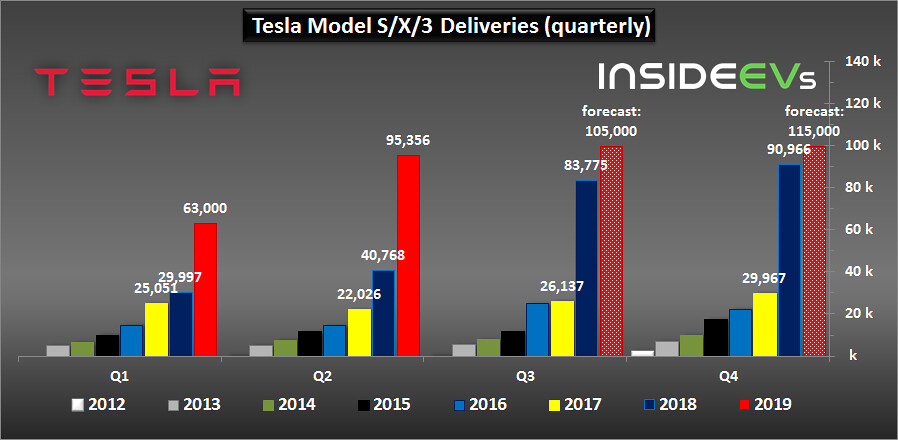To meet the guidance of 360,000 to 400,000 car sales in 2019, 200,000 need to be sold during the second half of the year.
The second quarter was a record one for Tesla, with 95,356 deliveries (158,356 in H1). There are signs that it was the last quarter below 100,000 though.
Currently, the Model 3 represents more than 80% of total Tesla car sales (part of the reason is a decrease in Model S/Tesla Model X sales).
Tesla H1 2019 results:
- Production: 87,048 (up 63% year-over-year)
- Model 3: 72,531 (up 154%)
- Model S/X: 14,517 (down 41%)
- Sales: 95,356 (up 134% year-over-year)
- Model 3: 77,634 (up 321%)
- Model S/X: 17,722 (down 21%)
Tesla sticks to its previous car sales guidance of 360,000 to 400,000 in 2019. To achieve the lower target of 360,000, more than 200,000 cars need to be sold in the following two quarters or over 100,000 per quarter.
According to Tesla, the Fremont production plant is already able to produce 7,000 Model 3 per week. By the end of 2019, the combined production output of 3/S/X will be 10,000 per week or about half a million per year.
“The production rate of Model 3 continued to improve gradually throughout the quarter, breaking a monthly record in May and then again in June. All manufacturing equipment in Fremont has demonstrated capability of a 7,000 Model 3 vehicles per week run rate, which we continue to work to increase. We aim to produce 10,000 total vehicles of all models per week by the end of 2019.”
500,000 cars are be produced between July 1, 2019 and June 31, 2020.
Here is how 100,000+ sales per quarter would look on the chart:

A big factor for 2020 will be Gigafactory 3 output. The goal is to produce 150,000 Model 3 per year, but we are not sure how many will be made during ramp-up phase in 2020.
“Gigafactory Shanghai continues to take shape, and in Q2 we started to move machinery into the facility for the first phase of production there. This will be a simplified, more cost-effective version of our Model 3 line with capacity of 150,000 units per year – the second generation of the Model 3 production process. Just like in the US, the Model 3 base price of RMB 328,000 is consistent with its gas-powered competitors, even before gas savings and incentives. Given Chinese customers bought well over a half million mid-sizedpremium sedans last year, this market poses a strong long-term opportunity for Tesla. We are looking forward to starting production in China by the end of this year. Depending on the timing of the Gigafactory Shanghai ramp, we continue to target production of over 500,000 vehicles globally in the 12-month period ending June 30, 2020.”
